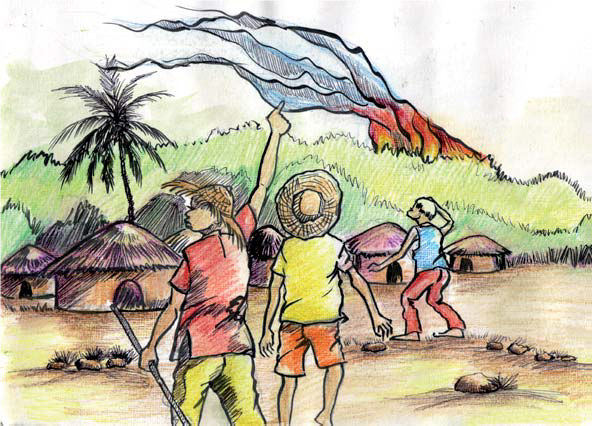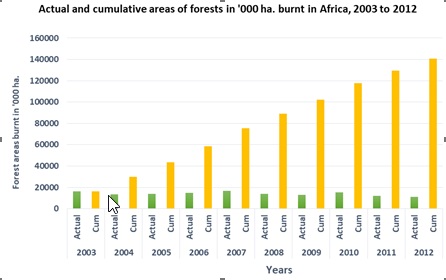Effective Wildfire Management: Pathway for sustainable livelihoods and biodiversity conservation in Africa
 |
Download the SCB Africa Section Policy Brief "Effective Wildfire Management: Pathway for sustainable livelihoods and biodiversity conservation in Africa"
The Challenge
While fire is one of the most important tools available to mankind, the lack of its mastery frequently leads to enormous human, environmental and economic damage each year.
Wildfires are usually accused of being the most pertinent threat to biodiversity and ecosystem integrity in the drier parts of Africa, where they are set by squatters and livestock graziers with the hope of better pastures, facilitation of hunting, collection of honey and in ceremonial events. The traditional slash and burn farming practice meanwhile is blamed for causing wildfires in the wet parts of the continent. In addition to devastating biological capital, wildfires are accused of reducing the water retention capacity of vegetation. As they pass over it, the canopy and below-ground sponge-like function of vegetation is destroyed, leading to prevalence of floods in the rainy season and empty riverbeds in the dry season.
Despite this gloomy assessment, the ecological importance of wildfires is unequaled; liberating species previously dominated and subjugated to death or extinction by others, breaking the dormancy of recalcitrant seeds, checking prevalence and eliminating pests and diseases of all species including mankind, improving climatic tolerance and resilience of species, enhancing functional ecological processes for several species including attracting new species, and more. Despite these challenges and opportunities, the determination to effectively manage wildfires is still derisory in Africa. Why is this?
Type and extent of wildfire and its management in Africa
African wildfires are usually small and occur frequently, unlike the single large ravaging types in countries of the northern hemisphere. Survey results have revealed that the impact of small frequent fires is usually equal and sometimes greater than that of single large fires. FAO Forestry Study n° 163 (FAO, 2010), reported that between 2003 and 2007, the average annual forest and woodland area burnt by wildfire in Africa was 83,180 km² while that of the whole world was 198,310 km².
Promote re-establishment of ecological processes by restoring or rehabilitating native flora that may have been compromised, damaged or eliminated by fire suppression actions or high intensity fires.
 |
|
Fig 1. Forest areas in ’000 hectares, burnt annually in Africa between 2003 and 2012 (green) and annual cumulative areas computed for same period (orange).Source: Computed from FAO Forest Resources Assessment, 2015. |
Africa’s small fires were responsible for 42% of the total annual forest and woodland area burnt and reported during the referred period. Rather fortunately, most African wildfires occur in the early dry season and contribute in checking the more damaging late dry season types. The graph above indicates, with the possibility of the same areas burnt annually, that the cumulative forest area burnt in Africa between 2003 and 2012 was 1,4Mkm² - an area twice the size of France. While specific information i.e. on frequency and dynamic ecology of African wildfires may be scarce, data on Fig 1 helps understand wildfires for the development of management strategies.
Some Key Actions
Due to the multi-jurisdictional nature of wildfires, a single community or agency may not have the ability to manage all wildfire situations. Communities, other actors and specialized agencies should preferably develop cooperative arrangements to mitigate their trans-sectorial and cross-community impacts.
- Envisage establishment of a national fire authority representing various fire management jurisdictions, to facilitate allocation of wildfire control inputs through coordinated action and policy implementation.
- Make provisions for the development of fire plans including communication strategies prior to the fire season on fire-prone resources, prioritizing trans-sectorial and cross community actions.
- Empower communities by facilitating legal land tenure while using local knowledge and experiences to develop appropriate fire policies and by-laws. This may include promoting the establishment of local fire management brigades.
- Pursue maintenance or restoration of appropriate fire regimes to enhance the vigour and diversity of populations of species and communities of native flora and fauna in fire-dependent ecosystems.
- Promote re-establishment of ecological processes by restoring or rehabilitating native flora that may have been compromised, damaged or eliminated by fire suppression actions or high intensity fires.
Anticipated Response
Bibliographical Sources :